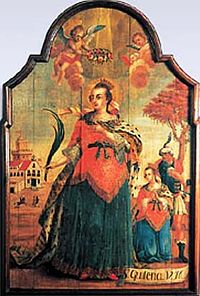Quiteria
| Saint Quiteria | |
|---|---|

18th-century Brazilian image of Saint Quiteria.
|
|
| Martyr | |
| Died | 5th century traditionally Aire-sur-l'Adour |
| Venerated in |
Roman Catholic Church Eastern Orthodox Church |
| Major shrine | Aire-sur-l'Adour |
| Feast | 22 May |
| Attributes | palm of martyrdom; depicted with a dog on a lead; depicted with her head in her hands, emerging from the sea. |
| Patronage | invoked against rabies;Higueruela; Meca (Alenquer) |
Saint Quiteria (Spanish: Quiteria; Catalan: Quitèria; Occitan: Quiteira; French: Quitterie; Portuguese: Quitéria; Tamil: கித்தேரியம்மாள், Kitheriammal) was a 5th-century virgin martyr, about whom nothing is certain except her name and her cult. She appears in the Roman Martyrology, but not in any other ancient calendars (such as the Martyrologium Hieronymianum).
Quiteria may be derived from Kythere (or Kyteria, Kuteria), a title applied to the Phoenician goddess Astarte which meant "the red one", or from (the possibly related name) Cytherea, an epithet of the Greek goddess Aphrodite, given because she was born on the island of Cytherea. Such origins of the name suggest to some that Saint Quiteria is fictional.
Her legend states that she was the daughter of a Gallaecian prince. Her father wanted her to marry and renounce Christianity. Quiteria fled and her father's men found her at Aire-sur-l'Adour, in Gascony. She was beheaded on the spot. Her sister Saint Libérate also suffered the same fate, was beheaded in the forest of Montus and lies in a 14th-century sarcophagus in the fortified church of Saint Jean Baptiste, Mazéres 32 km from her sister Quiteria in Aire-sur-l'Adour.
...
Wikipedia
